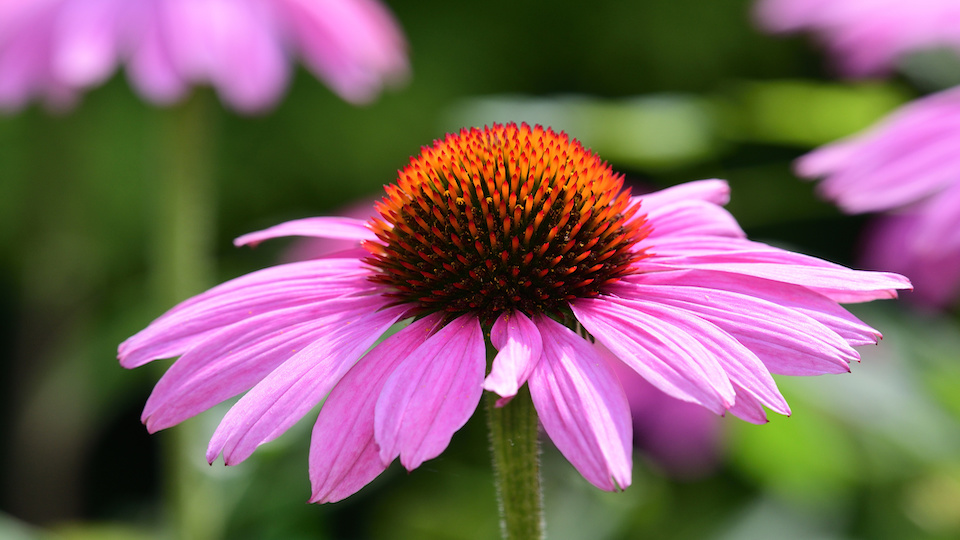It would almost be easier to list what echinacea can’t do rather than what it can. This vibrant purple plant is a veritable gold mine of healing properties and has been used for hundreds of years to treat many issues including pain, inflammation, migraines, and can even act as a remedy for the common cold and flu. So what exactly are the health benefits of this wonder herb and how can you grow it today?
Health benefits of Echinacea
Echinacea has a laundry list of beneficial compounds and nutrients that contribute to its stunning health profile, including cichoric acid, caftaric acid, flavonoids, polyphenols, vitamin C, selenium and zinc, echinacoside and various other polysaccharides and alkylamides.
Boosts the immune system
This herb is well-renowned and well-researched for its ability to boost the immune system and reduce the duration and symptoms of a cold or flu. In fact, it has been shown to reduce your chances of catching the common cold by 58 percent! Plus, drinking a cup of echinacea tea provides the added benefits of soothing your throat and keeping you hydrated while you’re sick.
Alleviates pain
Echinacea is an effective pain reliever and can reduce inflammation and discomfort from joint issues, muscle fatigue, and other injuries or tears.
Encourages wound healing
Applied topically, this herb can speed the healing of wounds and help fight infection. One study in rats showed its effectiveness against extensive necrosis of the skin, proving its value as a wound healing agent.
Boosts oral health
Orally ingested echinacea has been found to neutralize organisms that lead to halitosis and gingivitis. This is due to its potent anti-bacterial properties and cleansing capabilities. Take echinacea to help maintain oral health and keep your breath smelling fresh and clean.
May reduce anxiety
Though more human trials are needed to confirm the validity of echinacea as an anxiety management tool, research has been promising. High levels of echinacea given to adult test subjects over one week produced a marked decrease in anxiety. This notable change is perhaps due to the presence of alkamides, rosmarinic acid, and caffeic acid compounds in the herb.
Anti-inflammatory properties
This plant has been shown to have potent anti-inflammatory effects that can reduce chronic inflammation and pain. Since most people suffer from chronic inflammation, it is a good idea to take echinacea as a general anti-inflammatory instead of non-steroidal anti-inflammatory drugs (NSAIDS) such as ibuprofen that can cause serious health issues over time.
Tips for growing Echinacea:
Echinacea is available in forms such as capsules, tinctures, dried, essential oils, and teas, that utilize its roots and upper parts like the leaves and flower. However, growing your own echinacea is the easiest and safest way to ensure that you are getting a quality product with no added ingredients or harsh chemicals.
Echinacea or American coneflower refers to a group of brightly colored, flowering plants in the daisy family. This flower is not only an excellent herbal remedy but also deserves a prime spot in your garden for its eye-catching summer array. It is an incredibly hardy perennial that will return year after year and doesn’t take much water, which makes it perfect for desert landscapes. The beautiful purple hues attract pollinators such as butterflies and bees, so if you are searching for great additions to your pollinator garden, look no further!
Technically, the group Echinacea is made up of nine species, but only three are used medicinally. If you seek to grow this herb for health purposes, it is important that you grow one of the following species: Echinacea purpurea, Echinacea angustifolia, or Echinacea pallida.
- Coneflowers are hardy but will do best in rich, well-drained soil
- Mix fertile organic matter such as compost into the soil before planting
- They prefer full sun but are fairly adaptable and can deal with part sun
- Sow outdoors from seed, ½ inch deep. Early in the season when a light frost is still possible
- Apply a quality organic flower fertilizer a few times during the growing season to encourage full, vibrant blooms
- Pinch or cut off spent flowers to lengthen the growing season
- Be sure to keep a thick layer of mulch around the base of the plant to prevent weeds and conserve moisture
- Water well but be sure not to let the soil stay moist
- Cut Echinacea all the way to the ground in late winter once flowers have gone to seed
-Taylor Ramsey




